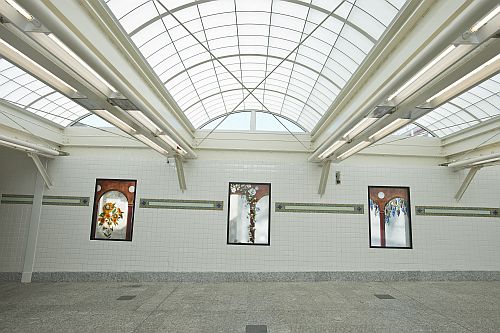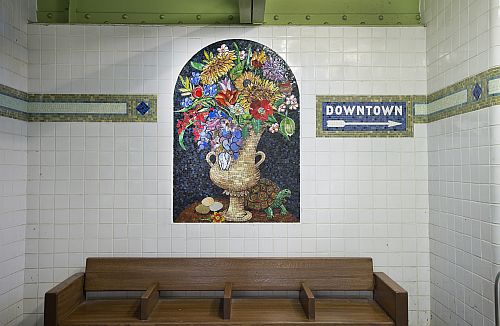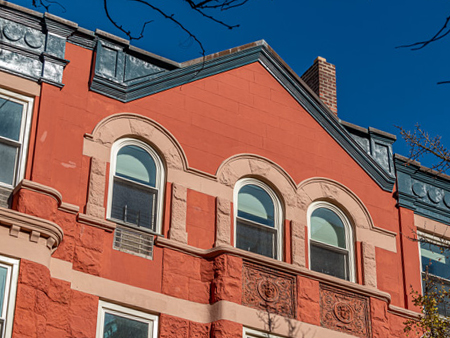It used to be known as the Grand Central of the Bronx, a train administration center that later became a subway station that slid into disrepair has been restored. The MTA reports,
The MTA’s top-to-bottom rehabilitation of the East 180th Street 25 subway station has recaptured the grandeur its original builders had in mind when the century-old North Bronx transit terminal served as the administration building for the old New York, Westchester and Boston Railway system.
The two-year, $66.5 million project breathed new life into the unique subway station that serves the and lines and is a major link to two major Bronx attractions – the Bronx Zoo and the New York Botanical Gardens. Designed and built during a period when riding the rails was a grand experience rather than bookends to a work day, the structure is a handsome example of early 20th Century architectural design that has long stood as a community landmark.
“This beautifully renovated station is a tribute to the Bronx and provides an uplifting experience for everyone who passes through it,” said MTA Acting Chairman Fernando Ferrer. “I’m very pleased the MTA has restored an element of the Bronx’s glory while improving the daily commutes of its residents.”
The stucco, red terra cotta-tiled roof building boasts a pair of four-story towers, entry 
“The subject of this project serves to demonstrate the architectural variety of the New York City subway system and the care and effort that goes into maintaining the system and restoring elements to their original appearance,” said NYC Transit President Thomas F. Prendergast. “The East 180th Street Station was built to a grand design by its original operator and we have taken the opportunity to return it to as close to its original condition as possible.”
Work on the station required restoration of the landmark building’s exterior walls, windows, stucco work, roof tiles wood doors and mezzanine areas. Of course, this type of work required skilled craftspeople. There are two retail spaces in the station’s lobby, as well as NYC Transit employee facilities for Rapid Transit Operations, Signals and Structures.
“This was a tremendously rewarding job, bringing the station back up to a state of good 
Major portions of the project, designed by Lee Harris Pomeroy Architects, included the refurbishment of the mezzanine passage with new tile work and ornamental mosaic bands and the introduction of mosaic panels designed under guidance of the MTA Arts for Transit program. The station’s side entrance has been rehabilitated and the designs of both passageways are marked by large spans of structural steel overhead, painted a pale green the same as they were when the station was first opened. New lighting has been installed on the building’s interior and exterior, making the station as attractive by night as by day.
The elevated subway platforms have similarly been rehabilitated, including new platforms, edge safety tiles, canopies and track beds. ADA compliance is achieved through a new pathway that allows wheelchair access and the installation of two elevators that link the mezzanine to the platforms.
New tile work and ornamental mosaic bands and panels have been installed. Designed by 
One important element was donated to the project by construction contractor Citnalta. Company President Mike Gargiulo visited the job and felt that the historic building was missing just one thing – a clock. Having studied historical preservation in college, he thought a clock would add a lot to the project.
Some electronic sleuthing turned up old images showing the original clock. A similar item was sourced from Electric Time Co. in Massachusetts. The old images were sent up to them and they suggested a clock that would fit the design of the early 20th Century transportation building.
“We at Citnalta, with NYC Transit’s and Lee Harris Pomeroy’s permission, donated the clock and the installation, because we thought it completed the look, making a great renovation just a little bit nicer,” said Gargiulo.
The northern segment of the 5 train, known as the Dyre Avenue Line of the New York City subway system, was once part of an electrified commuter railway connecting the South Bronx with White Plains and Port Chester in Westchester County.
Owned by the New Haven Railroad, the New York Westchester and Boston Railway were short-lived, in service only between 1912 and 1937. New York City took ownership of the Bronx portion of the line in 1940 and tied into the IRT at East 180th Street.




